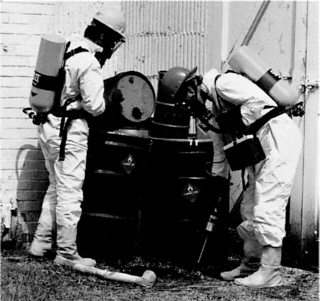The Work of COT
After 50 years and more than 700 studies and reports, COT's publication list (see Appendix) reflects the breadth and depth of modern toxicology, occupational health, and environmental health science. COT's work has included: (1) many contributions to the development of scientific approaches for toxicological risk assessment involving continuous, intermittent, or emergency (short-term) exposures; (2) vast numbers of substances evaluated for toxicity and health effects; and (3) a broad range of toxicological topics and concerns.
APPROACHES IN TOXICOLOGY
COT has contributed in many ways to the development of the field of toxicology through its work on toxicological approaches for evaluating health hazards and risks. The committee has helped the Coast Guard to develop classifications and rating systems for hazardous materials (1964) and has helped other agencies to develop operational and safety procedures for handling toxic materials and mixtures, including protocols for monitoring, surveillance, and testing. COT has helped NASA to develop guidelines for monitoring atmospheric contaminants in spacecraft (1992) and has reviewed methods for Air Force epidemiologic studies, including protocols for its study of health effects of exposure to Agent Orange and its contaminants (1980). COT has also issued a number of reports addressing principles for conducting evaluations and criteria for develop-
ing emergency and continuous exposure levels for toxic substances (see shaded box). A number of COT reports have been aimed at establishing the toxicity of various categories of substances, such as engine fuels (1976) and household substances (1977). COT has published guidelines, later adopted by EPA, on principles for evaluating chemicals in the environment (1974) and for developing emergency exposure guidance levels for civilian communities (1993).
|
COT Reports on Emergency Exposure Guidelines Basis for Establishing Emergency Inhalation Exposure Limits Applicable to Military and Space Chemicals (1964) Basis for Establishing Guides for Short-Term Exposures of the Public to Air Pollutants (1971) Criteria for Short-Term Exposure to Air Pollutants (1979) Criteria and Methods for Preparing Emergency Exposure Guidance Level (EEGL), Short-Term Public Emergency Guidance Level (SPEGL), and Continuous Exposure Guidance Level (CEGL) Documents (1986) Guidelines for Developing Spacecraft Maximum Allowable Concentrations for Space Station Contaminants (1992) Guidelines for Developing Community Exposure Levels for Hazardous Substances (1993) |

Disposal and cleanup of toxic chemicals at an Army installation.
SUBSTANCES EVALUATED
During the past 5 decades, COT has analyzed scientific data on hundreds of potentially toxic materials to which military or civilian personnel or the general public might be exposed. Some of the materials are peculiar to military applications, but many others are common in a modern industrial society, particularly in the petrochemical, transportation, and electronics sectors. Still other materials have broad applications and can be found around the home or on farms. It would take many pages to specify all the chemicals evaluated by COT; the following shaded box illustrates the variety of materials evaluated:
|
Examples of Materials Evaluated by COT Chemical-warfare agents and their precursors Submarine and spacecraft contaminants Munitions—explosives, pyrotechnics (e.g., signal flares), smokes, and obscurants Rocket propellants (e.g., hydrazines) Fuels—jet fuels, fuel additives, rocket propellants, diesel and rocket exhausts, and other combustion products Engine fluids—hydraulics, lubricants, coolants, and anticorrosion agents Coatings—dyes, paint additives, varnishes, sealants, adhesives, and adhesive removers Cleaners— solvents, dry-cleaning fluids, detergents, disinfectants, and sterilants Biocides—pesticides (especially insecticides), herbicides (including paraquat and Agent Orange), and fungicides (e.g., for protecting leather boots) Toiletries—insect repellents, sunscreens and other protective creams, shampoos, and camouflage face paint Food-related substances—purifying agents and contaminants in potable-water systems, anticorrosion agents in food-service equipment, fuels for heating rations, heat-sealed plastic wrapping for meats, and preservatives for wooden chopping blocks Miscellaneous substances—duplicating fluids, heat-sensitive and electrosensitive recording papers, shrink-proofing and fire-retardant treatments for uniforms, refrigerants, and fire-extinguishing foams and other agents |




